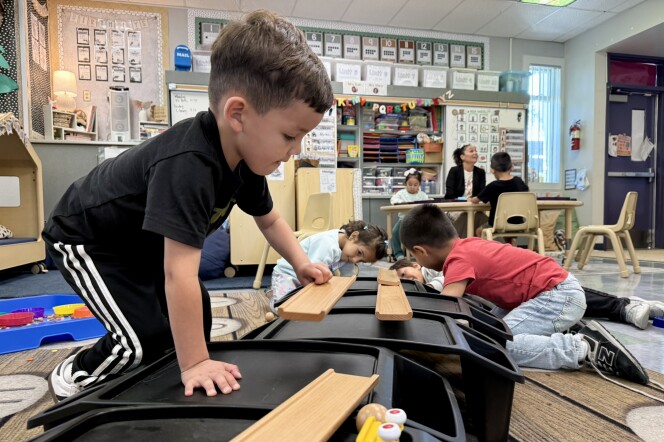With our free press under threat and federal funding for public media gone, your support matters more than ever. Help keep the LAist newsroom strong, become a monthly member or increase your support today.
4 steps to help you avoid sharing election misinformation

While Election Day is November 5, early voting started in September in some states. As we wait for the final results to be declared, chances are, you’re going to come across false or misleading information.
To avoid spreading misinformation this election season, here are four things to consider.
We won’t know the full picture the night of November 5
Election rules and procedures vary state by state. Within a state, they can even vary between counties. Some states allow mail-in ballots received before Election Day to be processed in advance. Others leave the processing and counting of mail-in ballots until after the polls close on Election Day.
This means results can shift dramatically over the course of election night, depending on which ballots are counted first. This happened in 2020 when states where then-President Donald Trump seemed to lead shifted in favor of Joe Biden late in the evening.
If you react strongly to new information, pause
It’s normal to have an emotional response to information you encounter online or in the news. But if the information you just received elicits a particularly strong emotion in you, that might be a signal to hit the brakes, said Rachel Moran of the University of Washington’s Center for an Informed Public. “A lot of misleading information is created intentionally to sow confusion or to create an emotional reaction. So if it's doing that in you, it doesn't necessarily mean that what you've read is wrong, but it is a good cue to sort of slow down,” she said.
We have a desire to see our beliefs reflected back to us, so it’s easy to agree with something if it reinforces our worldview — even if it’s not true, said Hannah Covington, senior director of education content at the News Literacy Project. “When you see information that you just automatically agree with, that’s really a signal to pause and maybe do a quick search.”
Consider how trustworthy your source of information is
Open up your preferred search engine and do a quick keyword search to see what other trustworthy sources are saying about the piece of information you’re evaluating. “If you don’t see something reported by multiple news outlets, then it’s probably time to just wait [before sharing],” said Covington.
When considering whether a news source is trustworthy, look for how it handles errors in its reporting. Trusting a source that makes errors might seem counterintuitive, “but actually correcting information when there's an inaccuracy is a huge sign of credibility,” Covington told NPR.
Apply caution with information that’s been translated from another language. A good translator requires knowledge of the language and the culture so they can discern whether the original message is meant to be satirical or ironic, said Laura Zommer, co-founder and CEO of Factchequeado.
If you receive a message on WhatsApp that’s marked as “forwarded” or “forwarded many times,” “be especially cautious, as this indicates that the author of the content is unclear and not the person who sent [you] the message,” Zommer told NPR in an email.
Be wary of what photos and videos are supposed to “prove”
Take care when evaluating images, video and audio. They are easily manipulated or taken out of context. Take this 2020 tweet alleging voter suppression, supposedly evidenced by a photo of a pile of mailboxes. It reads, “Photo taken in Wisconsin. This is happening right before our eyes. They are sabotaging USPS to sabotage vote by mail. This is massive voter suppression and part of their plan to steal the election.”
UCLA law professor Richard L. Hasen investigated the claim in his 2022 book, Cheap Speech: How Disinformation Poisons Our Politics – And How To Cure It. As it turns out, while the photo is real, the allegation of voter suppression was not. The mailboxes were pictured outside of a business which had a contract to repair old mailboxes for the U.S. Postal Service, not scrap them.
In this day and age, Moran said “the old adage … ‘seeing is believing’ just doesn't really hold truth anymore.” When you come across a piece of media online, it’s worth asking: “is what I’m hearing or seeing AI generated? Or could it be real and edited in a deceptive fashion?”
Ultimately, “it’s up to us to protect ourselves and our communities [from misinformation] by only sharing what’s verified,” said Covington.
NPR's Brett Neely contributed reporting to this story.
About the vote in California
About the vote count
As you watch these results, keep in mind:
- There more more than 22.6 million registered voters in California.
- In 2020, the last presidential election, more than 16.1 million Californians cast a ballot.
Get full results:
Keep in mind that in tight races the winner may not be determined for days or weeks after Election Day. This is normal. Here's why.
In California, ballots postmarked on or before Nov. 5 are counted toward the results as long as they arrive within seven days of the election. The California Secretary of State's Office is scheduled to certify the final vote on Dec. 13.
Copyright 2024 NPR. To see more, visit npr.org.










